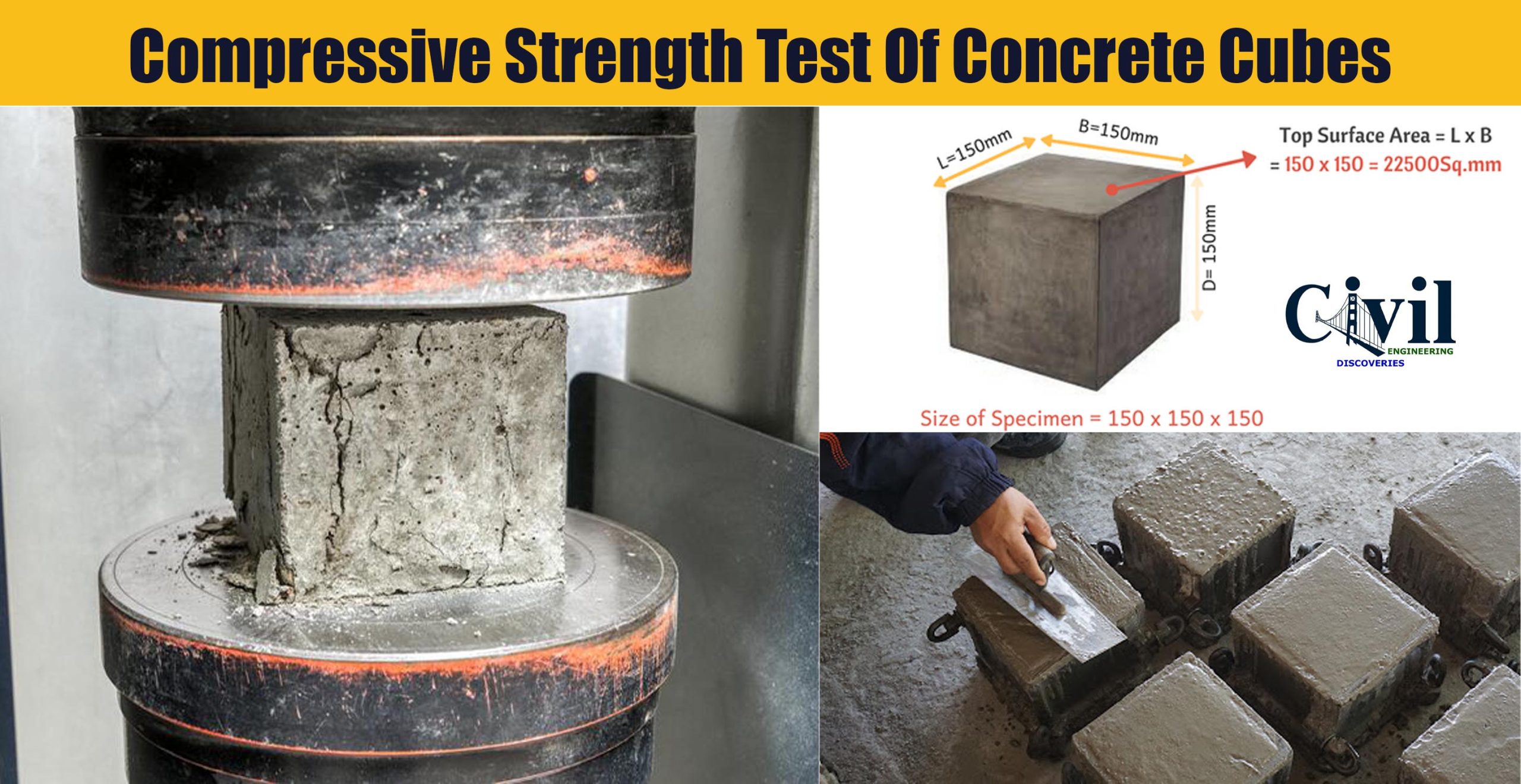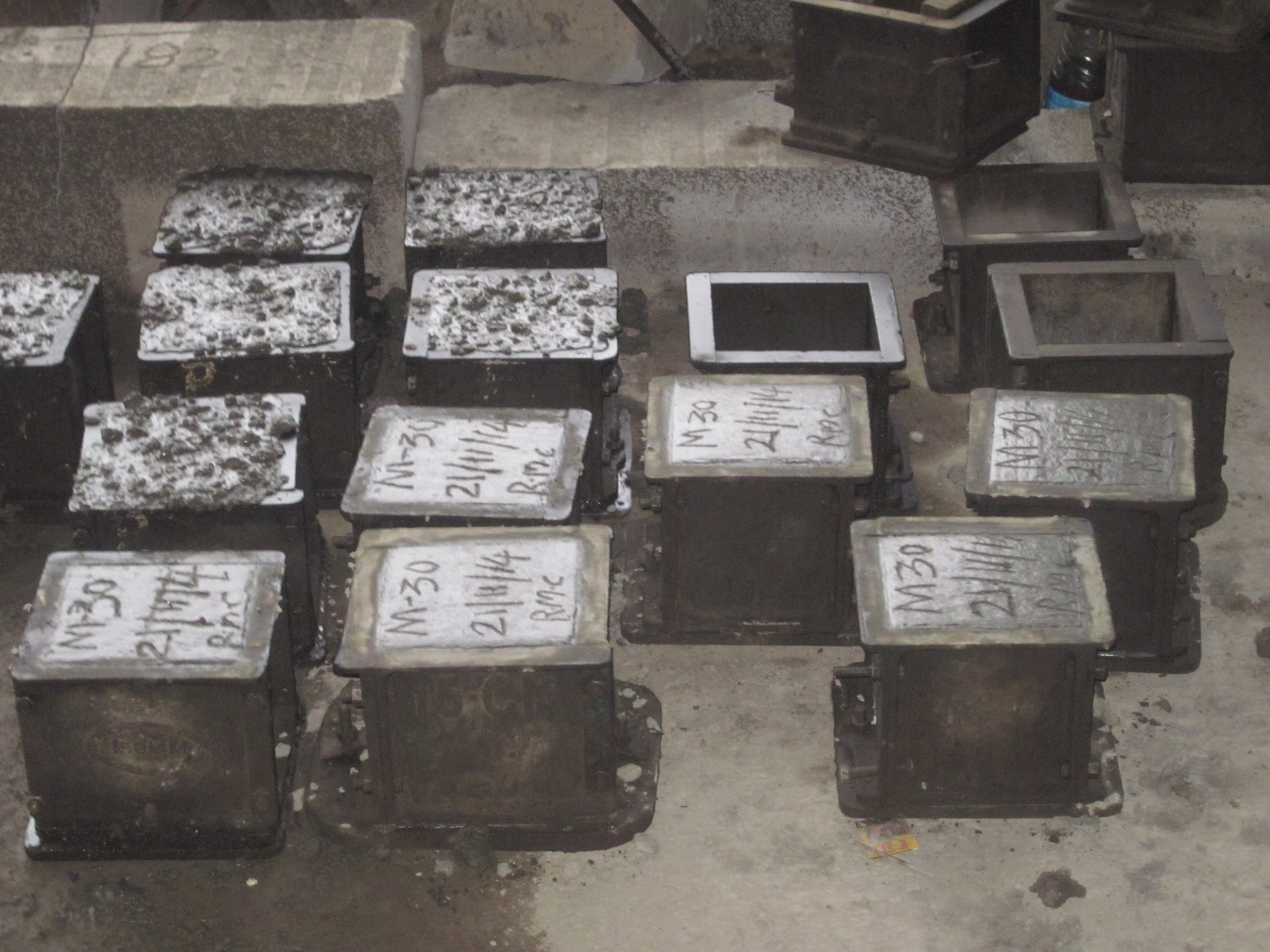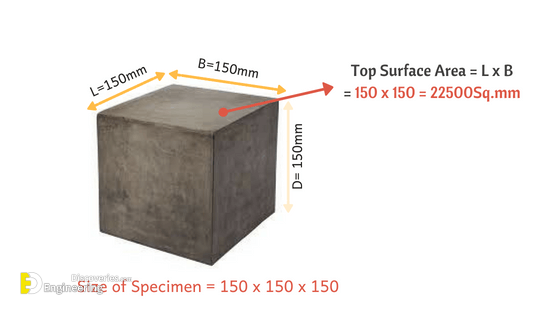This test is considered as the most popular test performed on concrete in construction as it gives a general idea on all the characteristics of concrete. Based on this test, one can either accept or reject concrete work. Compressive strength as a concrete property depends on several factors related to the quality of used materials, mix design and quality control during concrete production. Depending on the applied code, the test sample may be cylinder [15 cm x 30 cm is common] or cube [15 cm x 15cm x 15 cm is the most common]. For example, as per ASTM C39, a standard test method is given to get the compressive strength of concrete cylinders.
Compressive Strength Test Idea
1- Concrete is poured in the mould and compacted properly to reduce the number of voids.
2- After 24 hours, moulds are removed and test specimens are then placed in water for curing.
3- After the specified curing period [3, 7, 28, 56, or 91 days], specimens are tested by the compression testing machine.
4- Load is applied gradually until specimen failure.
5- Divide failure load by cross-sectional area of the specimen to get the compressive strength of concrete.
Compressive Strength Test Procedure
Tools/Apparatus
Compression test machine, moulds, mixer, trowel, tamping rod (steel bar 16 mm diameter and 60 cm long)
Sample preparation
Samples are taken from the concrete patches used in the site or prepared with the same mixture as used in the field.
Specimen size: 3 cylinders [15 cm x 30 cm] or 3 cubes [15 cm x 15cm x 15 cm]
Minimum three specimens should be tested at each selected age. The Average of there specimens gives the strength of concrete.
Concrete Mixing
1- By laboratory batch mixer, or
2- by hand: First, mix the cement and fine aggregate until the mixture is thoroughly blended. Then, add the coarse aggregate and mix until the coarse aggregate is uniformly distributed. Finally, add water and mix until the concrete appears to be homogeneous and of the required consistency.
Pouring Concrete into moulds
1- Clean the moulds properly and finish it with oil so that concrete will not stick into the mould and make latter cleaning difficult.
2- Put concrete in the moulds layer by layer. Each layer is around 5 cm thick. Each layer is compacted with a tamping rod [35 strokes]
3- Level the top surface with a trowel
Curing Of Concrete Cubes
1. Keep the specimens in a place, free from vibration, in moist air and at a temperature of 27°C ±2° C for 24 hours.
2. After 24 hours, mark and remove the samples from the mould.
3. Submerge the cubes immediately in fresh and clean water until taken out prior to the test. The water should be renewed every 7 days.
Procedure Of Compressive Test
1. Remove the specimens from the water before 30 minutes of testing.
2. Remove any loose sand or other material from the surface of the specimens and let them dry.
3. Clean the bearing surface of the compression testing machine.
4. Now place the cube in the testing machine in such a manner that the load is applied o the opposite sides of the cubes.
5. Align the axis of the specimen with the centre of thrust of the spherically seated platen.
6. Apply the load increasingly at a rate of 140 kg/cm² per minute until the cube collapse.
7. Note down the maximum load applied to the specimen and any other unusual activities at the time of failure.
Calculation
The surface area of specimen: = 150 x 150 = 22500mm² = 225cm²
Assume, The Max compression load is 450KN
1KN = 1000N ; 450Kn = 450×100 = 450000N
Compressive Strength of Concrete = 450000 /22500 = 20N/mm² = 203Kg/cm²
The same calculation is done for the specimen at different ages as stated below
| Details | Specimens | ||
|---|---|---|---|
| Specimen 1 @ 7 days | Specimen 2 @ 14 days | Specimen 3 @ 28 days | |
| Max load that Specimen bear (Assumed Test results) | 310KN | 408KN | 445KN |
| Compressive Strength in N/mm² | 310000/22500 = 13.7N/mm² | 408000/2250 =18.13N/mm² | 448000/2250 = 19.9N/mm² |
| As we assumed M20 grade concrete mix which bears a max load up to 20N/mm²
| |||
| Minimum Strength to be achieved at different days | 65% @7 days | 90% @14 days | 99% @28 days |
| Percentage of Concrete gain (test results) | (13.7×100)/20 = 68.5%>65% | (18.13×100)/20 = 90.6%>90% | (19.9×100)/20 = 99.1%>99% |
| A good concrete should not show less than the minimum Compressive strength at respective days. Hence concrete is safe to use.
| |||
Important Note: As per IS: 516-1959 Minimum three specimens should be tested at each selected age (that means three specimens at 7 days, three specimens @ 14 days and 28 days) If the strength of any specimen varies by more than 15% of average strength, such specimen should be rejected.
Results of cube test
Average Compressive strength at 7 days = _____N/mm²
The average Compressive strength at 28 days = _____N/mm²
Guidance
The following table gives the strength of concrete at different ages as a percentage of the strength at 28 days in order to accept the test result.
| Age | % of 28 day Strength |
| 1 day | 16% |
| 3 days | 40% |
| 7 days | 65% |
| 14 days | 90% |
| 28 days | 100% |
Click Here To See Tips To Calculate The Weight Of A Concrete Cube








